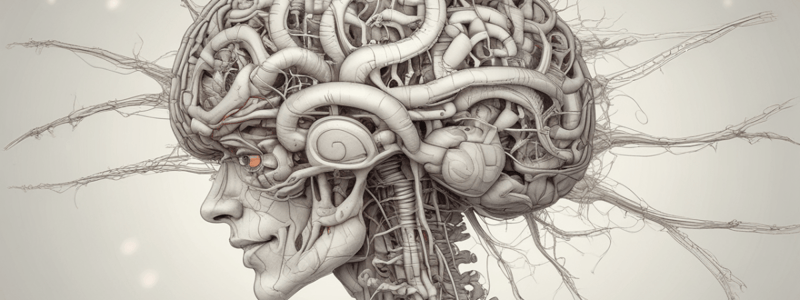Podcast
Questions and Answers
¿Cuál es la función del cráneo en relación con el encéfalo?
¿Cuál es la función del cráneo en relación con el encéfalo?
- Proteger el corazón
- Proteger el encéfalo (correct)
- Sostener la columna vertebral
- Regir el crecimiento del cabello
¿Qué partes componen el encéfalo?
¿Qué partes componen el encéfalo?
- Cerebro, médula espinal y nervios craneales
- Cerebro, cerebelo y tronco del encéfalo (correct)
- Cerebelo, tronco del encéfalo y nervios craneales
- Cerebro y médula espinal
¿Cuál es la ubicación del encéfalo en el cuerpo humano?
¿Cuál es la ubicación del encéfalo en el cuerpo humano?
- En el tórax
- En el cráneo (correct)
- En la columna vertebral
- En la cavidad abdominal
¿Cuál es la función del tronco del encéfalo?
¿Cuál es la función del tronco del encéfalo?
¿Qué sistema del cuerpo humano comprende el encéfalo?
¿Qué sistema del cuerpo humano comprende el encéfalo?
¿Dónde se encuentra la médula espinal?
¿Dónde se encuentra la médula espinal?
¿Qué estructura conecta la médula espinal con el encéfalo?
¿Qué estructura conecta la médula espinal con el encéfalo?
¿Qué parte del sistema nervioso central es la médula espinal?
¿Qué parte del sistema nervioso central es la médula espinal?
¿Qué rodea la médula espinal?
¿Qué rodea la médula espinal?
¿Cuál es la relación entre la médula espinal y el encéfalo?
¿Cuál es la relación entre la médula espinal y el encéfalo?
Los nervios son vías de información solo centrípeta.
Los nervios son vías de información solo centrípeta.
Los nervios conectan los receptores sensoriales con los órganos efectores.
Los nervios conectan los receptores sensoriales con los órganos efectores.
Los nervios son solo fibras nerviosas periféricas.
Los nervios son solo fibras nerviosas periféricas.
Los nervios se encuentran solo en el Sistema Nervioso Central.
Los nervios se encuentran solo en el Sistema Nervioso Central.
Los nervios son responsables de transmitir información desde el SNC a los músculos.
Los nervios son responsables de transmitir información desde el SNC a los músculos.
Match the following functions with the system responsible:
Match the following functions with the system responsible:
Match the following bodily functions with their characteristics:
Match the following bodily functions with their characteristics:
Match the following bodily processes with the system responsible:
Match the following bodily processes with the system responsible:
Match the following bodily systems with their functions:
Match the following bodily systems with their functions:
Match the following bodily functions with the nervous system responsible:
Match the following bodily functions with the nervous system responsible:
Match the following functions with the system responsible:
Match the following functions with the system responsible:
Match the following bodily functions with their characteristics:
Match the following bodily functions with their characteristics:
Match the following bodily processes with the system responsible:
Match the following bodily processes with the system responsible:
Match the following bodily functions with the nervous system responsible:
Match the following bodily functions with the nervous system responsible:
Match the following bodily functions with their characteristics:
Match the following bodily functions with their characteristics:
Study Notes
Sistema Nervioso Central
- El encéfalo es la parte del sistema nervioso central que se encuentra dentro del cráneo.
- El encéfalo está compuesto por el cerebro, el cerebelo y el tronco del encéfalo o encefalíco.
Médula Espinal
- La médula espinal es la parte del sistema nervioso central que se encuentra dentro del canal vertebral.
- La médula espinal se conecta con el encéfalo a través del agujero occipital del cráneo.
Estructura y Función de los Nervios
- Los nervios son haces de fibras nerviosas periféricas que se encargan de transmitir información.
- Estas vías de información se clasifican en dos tipos: centrípetas y centrífugas.
- Las vías centrípetas se encargan de transmitir información desde los receptores sensoriales hasta el SNC (Sistema Nervioso Central).
- Las vías centrífugas se encargan de transmitir información desde el SNC a los órganos efectores, como glándulas y músculos.
- La transmisión de información a través de los nervios permite la comunicación entre el SNC y el resto del cuerpo.
Sistema Nervioso Autónomo
- Regula funciones corporales involuntarias
- Controla funciones que no están bajo nuestro control voluntario
- Ejemplos de funciones reguladas:
- Flujo sanguíneo
- Latidos del corazón
- Digestión
- Respiración
Sistema Nervioso Autónomo
- Regula funciones corporales involuntarias
- Controla funciones que no están bajo nuestro control voluntario
- Ejemplos de funciones reguladas:
- Flujo sanguíneo
- Latidos del corazón
- Digestión
- Respiración
Studying That Suits You
Use AI to generate personalized quizzes and flashcards to suit your learning preferences.
Description
Aprende sobre la estructura y función del encefáložo, incluyendo el cerebro, el cerebelo y el tronco del encefáložo.




